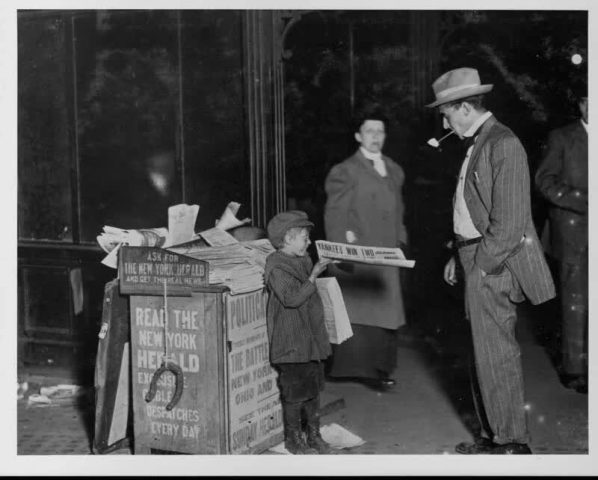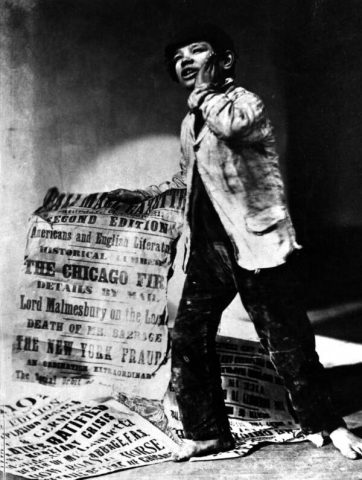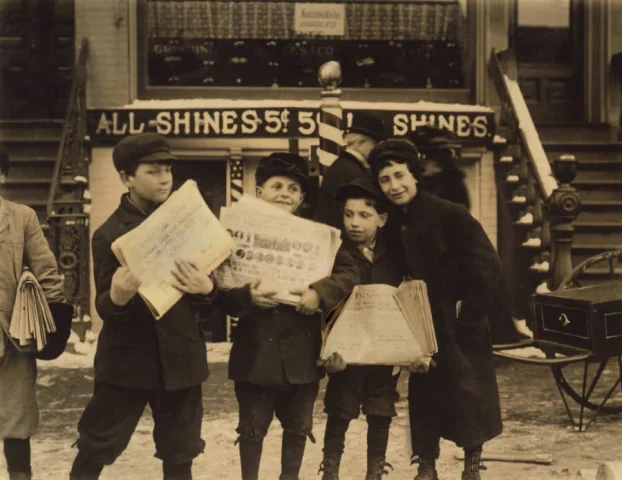
Beginning in the 1840s, young boys called “newsies” sold newspapers in major cities across the U.S. in order to make a living or support their struggling families — and as these photos show, the job wasn’t always easy.
Amid the chaotic muddle of turn-of-the-century American cities, commuters striding to or from work would almost certainly encounter young children selling newspapers. These newsboys, or newsies, made up an essential thread in the fabric of American urban life.
Sometimes as young as five or six, newsies emerged in the mid-19th century alongside affordable newspapers. They collected bundles from publishers and hawked the day’s latest stories for a penny in hopes of making money for their families or themselves.
Though young — and, in the beginning, often homeless — newsies made up a powerful collective force. When newspaper publishers tried to raise bundle prices in 1899, newsboys in New York went on strike. They managed to wring concessions from powerful publishers, as depicted in the 1992 movie Newsies.
These 44 newsies photos capture a slice of their lives between the 19th and 20th centuries, when a young child with ambition and a loud voice could scrape together a meager wage by selling papers on the street.
The Rise Of The Newsboy
At the onset of the 19th century, newspapers were too expensive for many to afford. The New York Times reports that they cost around five cents, which was prohibitively expensive for workers who made just a dollar a day.
This changed in the 1840s. The invention of the rotary press ushered in the era of “penny papers,” which the masses could afford, as well as the need for workers to sell them. Before long, the dozens of dailies in cities like New York were hawked by young children, called newsboys or “newsies.”

Newsboys, sometimes as young as six, were poor and often homeless. They paid for the papers that they sold and suffered when sales were bad.
“There are 10,000 children living on the streets of New York… The newsboys constitute an important division of this army of homeless children,” one man wrote of newsies in 1872, according to the Gilder Lehrman Institute of American History. “You see them everywhere… They rend the air and deafen you with their shrill cries. They surround you on the sidewalk and almost force you to buy their papers. They are ragged and dirty. Some have no coats, no shoes and no hat.”
Though young and poor, newsies became an important part of American urban life. They came to play such a crucial role that they were able to stand up to powerful newspaper publishers at the end of the 19th century.
The Newsboy Strike Of 1899
Newsies and newspaper moguls in New York City long had a symbiotic relationship. Newsboys would buy 100 papers for 50 cents and then sell them for one cent each. Though publishers raised bundle prices to 60 cents during the Spanish-American War in 1898, newsies didn’t mind because everyone wanted to buy a paper and read about the conflict.
but after the war ended, moguls William Randolph Hearst and Joseph Pulitzer kept charging the newsboys 60 cents for 100 papers. And the newsies started feeling the difference.

Angered by the cost of newspaper bundles, newsies gathered to form a union. Though publishers initially dismissed the newsboy strike of 1899, they soon realized that the strikers were serious.
The newsboys marched, threatened the offices of the New York World and the New York Journal with clubs, and endeared themselves to the public. The World’s circulation plummeted, and the paper’s managing editor, Don Seitz, wrote a number of increasingly panicked memos to Pulitzer.
“The people seem to be against us,” Seitz told his boss on July 24. “They are encouraging the boys and tipping them… [and] they are refraining from buying the papers for fear of having them snatched from their hands.”
In the end, the newsboys and the newspaper moguls came to an agreement. The bundles would stay at 60 cents, but newsies could sell back any unsold papers for a full refund at the end of the day. With that, the strike ended.
The End Of The Era Of ‘Extra, Extra!’
Following the newsboys’ strike of 1899, life for newsies largely continued as it always had. Many continued to live in poverty, though fewer were homeless.
“The newsboy of today,” the superintendent of a “newsboys’ lodging house,” told photographer and activist Jacob Riis in 1912, per American Heritage, “is a commercial little chap who lives at home and sells papers after school hours.”
As time went on, and child labor laws were put into place, newsies became all but obsolete. But they certainly captured the American imagination. In 1992, the Disney musical Newsies told the colorful story of the 1899 strike almost a century after it took place.
Above, look through 44 newsies photos that capture what life was like for newsboys — and girls — in American cities across the nation.





